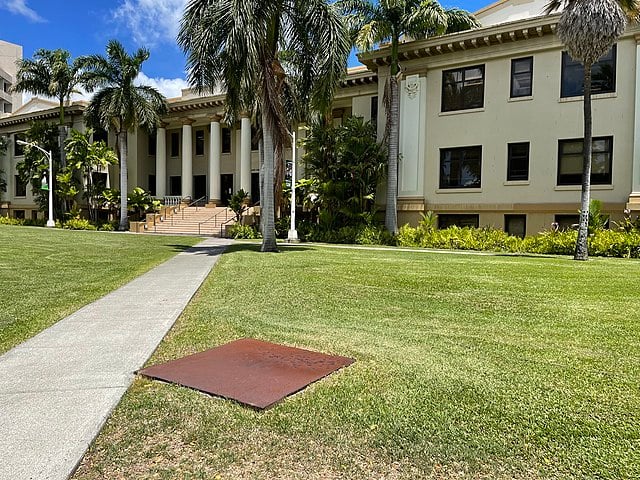The University of Hawaii’s flagship Mānoa campus is situated just outside of downtown Honolulu on the island of Oahu, in what is considered to be the happiest, healthiest, and (#2) safest state in the U.S.
Not only that, Hawaii is also ranked at the top when it comes to environmental quality.
With an average daily temperature of almost 78 degrees, it is not difficult to understand why UH Mānoa is receiving a historical number of applications.
Many who attend UH Mānoa go on to achieve great success in the business and political realms. 44% of Hawaii’s state senators and 51% of their state representatives graduated from UH Mānoa.
Other notable alumni include Richard Persons (former chairperson of Citigroup), author Michael Savage, and anthropologist/mother of President Barack Obama – Dr. Ann Dunham.
The school is best known for its trailblazing research initiatives in oceanography, astronomy, linguistics, genetics, and cancer research.
They also offer over 50 distance learning courses where students and instructors interact from all over the globe.
Reading ahead, we’ll share information that all interested applicants should consider before applying to UH Mānoa, including their acceptance and tuition rates, admissions requirements and deadlines, minimum GPA and standardized test score requirements, and top-notch programs.
University of Hawaii Acceptance Rate

Most recently, the University of Hawaii Mānoa campus accepted 58.4% of those applying for admission to the fall 2021 semester – out of 16,244 applicants, 9,493 were selected for admission, and almost 3,000 first-year students enrolled.
These numbers are significant for UH Mānoa, representing the largest increase in student enrollment since 2003, and the first time their flagship campus has enrolled over 19,000 students since 2014.
The record high can be attributed to the 34.6% increase in first-time freshmen, in which the university experienced a 22.7% increase in students enrolling in Hawaiian public schools, a 68.6% increase in students attending U.S. mainland high schools, and a 37.5% increase in international students.
UH Mānoa’s student body is currently ranked as the sixth most diverse university in the United States, with 60% coming from Hawaii, 34% from out-of-state, and 6% from over 120 countries and regions around the world.
They also boast a high-achieving first-year student cohort, with over half ranking in the top 25% of their senior graduating classes.
University of Hawaii Out-of-State Acceptance Rate
For the fall of 2021, UH Mānoa accepted 81.7% of Hawaiian applicants, 65.1% of U.S. mainland applicants, and 47.4% of international applicants.
Generally, these are favorable acceptance rates for all groups, particularly for out-of-state students.
The Western University Exchange (WUE) program at UH Mānoa is one offering that draws out-of-state applicants to the campus.
As part of the Western Interstate Commission for Higher Education (WICHE), WUE grants just a 150% tuition increase to students enrolled in 14 states in the western part of the U.S., including California, Alaska, and Colorado.
This discount is far more affordable than the standard out-of-state tuition rate, which we’ll discuss in a future section.
GPA for University of Hawaii

While there is no minimum GPA requirement for incoming first-year applicants, Hawaiian and U.S. candidates are expected to maintain a strong GPA and rank in the top 40% of their high school graduating class. International freshman applicants should have a cumulative GPA comparable to a 3.0 on a 4.0 scale.
UH Mānoa’s newest first-year cohort averaged a 3.68 GPA, which is up from 3.65 in the previous year.
According to the school’s most recent common data set, 47% of accepted students maintained a GPA of 3.75 or higher, 21% held a GPA between 3.5 and 3.74, and 16% had a GPA between 3.25 and 3.49.
SAT & ACT Requirements for UH
While there is no minimum SAT or ACT requirement for domestic applicants, international freshmen applicants are required to meet minimum scores.
For the ACT, applicants must have at least a combined score of 48 for the English and Reading sections, with individual scores of 21 or higher on each. Alternatively, the minimum SAT score in Critical Reading is 560.
Students can seek admission through the English Language Institute (ELI).
The ACT minimum is lowered to 43 total (with English and Reading scores of 19 or higher), and the SAT Critical Reading minimum is lowered 520.
U.S. News reports that half of the admitted applicants entering class in the fall of 2020 submitted SAT scores between 1060 and 120 or ACT scores between 20 and 26.
Other Requirements and Admission Tips

The University of Hawaii at Mānoa’s admission requirements are similar to many U.S. institutions: four English credits, three math credits, three science credits, three social science credits, four additional college prep credits, and five elective credits.
Homeschooled applicants should submit one of the following in place of an official high school transcript or diploma: ACT, GED, HiSET, SAT, or TASC scores.
In addition to submitting the University of Hawaii Mānoa Admission Application, applicants must send a $70 application fee and report all high school information through the Self-Reported Application. All admissions decisions will be based primarily on the information found in these materials.
Students are also encouraged – but not required – to share supplemental documents: a letter of recommendation, a personal statement, and a list of achievements.
Applicants can fill out the Letter of Recommendation Request Form, and an online recommendation form will be shared with the recommender to complete on behalf of the applicant.
We’ll talk more about the personal statement and list of achievements in the section that follows.
Students admitted to UH Mānoa may be asked to provide their official transcripts to the Office of Admission – typically for validation or scholarship purposes.
First-year applicants may also submit test scores as part of their application (which are not required).
For students hoping to enroll in the fall semester, the priority application deadline is January 5, the final deadline is March 1, and the late application deadline is May 1.
The school does have four programs that offer direct entry for high achieving first-year applicants: business, nursing, dental hygiene, and medicine.
Essays for University of Hawaii
Unlike many U.S. colleges, the University of Hawaii does not require applicants to respond to short-answer prompts or submit a traditional college essay.
The Mānoa application does, however, offer a section where students can write a personal statement and submit a list of achievements.
The personal statement is a chance for the applicant to state why they would like to attend UH Mānoa or how UH Mānoa fits into their career goals.
While there is no minimum or maximum word requirement, applicants should strive to be concise and share a story that distinguishes them from other candidates in a unique way.
This rule of thumb also pertains to the list of achievements section – while a long list of high school credentials may seem impressive, it might be more beneficial for an applicant to focus on one or two pivotal leadership roles, volunteer efforts, or other positions that informed their career path, changed their perspective, or motivated them in some way.
Ideally, any achievements listed will be relevant to the applicant’s intent to attend UH Mānoa.
Is the University of Hawaii Right for You?
The University of Hawaii offers exceptional programs that may be especially appealing to native Hawaiians and students in the western part of the U.S. (who can attend at a highly discounted tuition rate).
For residents, the total cost to attend UH Mānoa is approximately $30,000 per year, which breaks down to $11,304 in tuition costs, $13,642 in room and board payments, and remaining costs allocated to fees, personal expenses, books, and supplies.
Non-Hawaiian U.S. residents can expect to pay nearly $52,000 per year, with all fees comparable to Hawaiian fees except for tuition, which sits at $33,336 per year.
UH Mānoa’s WUE program charges a tuition of $16,956, which is highly preferable to the standard out-of-state tuition cost.
UH Mānoa’s geographical appeal is an obvious asset for the school, and with its location come highly recommended programs focused on environmental science, business, and health.
The U.S. News & World Report regularly ranks the Shidler College of Business’ international business focus among the top programs in the United States.
UH Mānoa also boasts the only research facility in the U.S. located within a tropical rainforest and the only research facility in the world constructed atop a coral reef.
The John A. Burns’ School of Medicine ranks #1 in the National Institutes of Health among community-based public medical schools – paired with the university’s direct entrance policy for the school of medicine, this makes UH a strong choice for students on the west coast hoping to get a head start with their career goals.
If a physical tour is not a possibility, interested students should take advantage of virtual tour offerings to see if UH Mānoa is the best fit for them.
Undoubtedly, students attending the school will love the location, diverse student body, and wealth of opportunities to participate in hands-on research.














